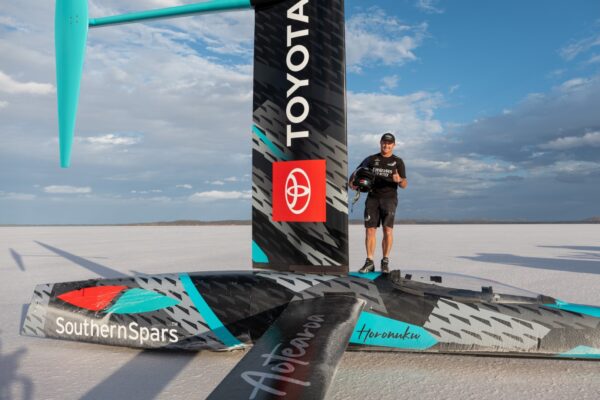Team New Zealand and Glenn Ashby create a new world record for wind-powered speed on land
Emirates Team New Zealand and the pilot Glenn Ashby reached a speed of 222.4 km/h with Horonuku, their wind-powered land vessel: it’s a world record

Emirates Team New Zealand and the pilot Glenn Ashby reached a speed of 222.4 km/h with Horonuku, their wind-powered land vessel: it’s a world record
Emirates Team New Zealand and the pilot Glenn Ashby reached a speed of 222.4 km/h with Horonuku, their wind-powered land vessel, establishing a new world record for wind-powered speed on land. This is yet another way to prepare for the next America’s Cup, which will, however, take place on the water, even if at the same crazy speeds.
“Horonuku” named by Ngāti Whātua Ōrākei, means “moving quickly on land” and that is exactly what it did, recording a record-breaking speed of 222.4 km/h with a wind speed of 22 knots over Lake Gairdner in Southern Australia.
At the helm was the pilot, Glenn Ashby, clearly pleased with the result, but also with the knowledge that Horonuku can go even faster. “The team and I – said Ashby – are obviously enthusiastic to have sailed on Horonuku at speeds faster than anybody else has done before, powered only by the wind. But we could say that we know that Horonuku can go even faster, having more wind and better conditions. So, yes we certainly have a reason to celebrate, but this isn’t the end.”
Before the speed of 222.4 km/h is declared “official,” a rigorous testing process must be undertaken in compliance with the international governing body, FISLY (Federation Internationale de Sand et Land Yachting), so the new world record can be ratified.
Observing the trial was an independent judge, approved by FISLY, to witness and verify the run, the GPS registration from the Horonuku and all the other requirements needed in the case of trying to beat a world record.
Horonuku has a GPS that measures speed using differential GNSS data (Global Navigation Satellite System), supplying 21 measurements per second. Each of these data points supplies and estimate of its position with a precision of approximately 10mm. This supplies an average speed per two seconds, the result of which is directly compared to that of the previous record of 202.9 km/h achieved by Richard Jenkins on 29 March 2009, a record that stood for over 5 thousand days.
“The Land Speed project – said Matteo de Nora, Principal for Emirates Team New Zealand – was a new opportunity to push the boundaries in aerodynamics, structural strength, construction methods and materials. What is often underestimated is that the technology we explore in challenges like this one, or in a campaign for the America’s Cup, are, in short, the fundamentals of tomorrow’s technology. Being ahead of the game in technology is what is fascinating in all the challenges the team has faced up until now.”
Topics: Glenn Ashby, world speed record







